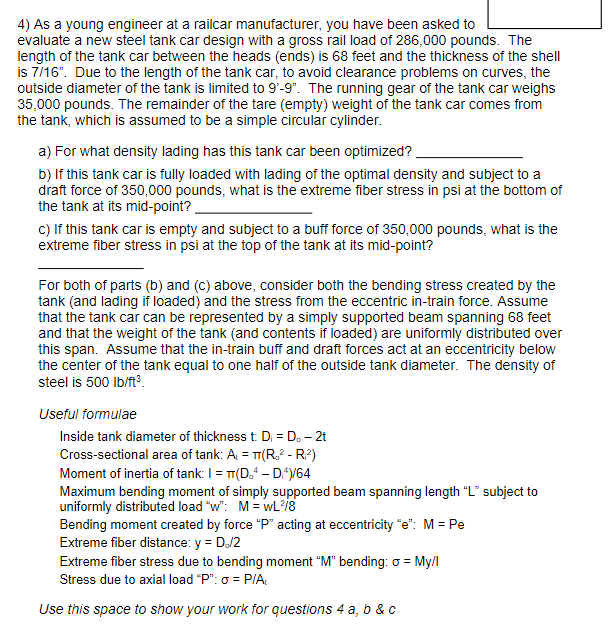Answered step by step
Verified Expert Solution
Question
1 Approved Answer
4) As a young engineer at a railcar manufacturer, you have been asked to evaluate a new steel tank car design with a gross

4) As a young engineer at a railcar manufacturer, you have been asked to evaluate a new steel tank car design with a gross rail load of 286,000 pounds. The length of the tank car between the heads (ends) is 68 feet and the thickness of the shell is 7/16". Due to the length of the tank car, to avoid clearance problems on curves, the outside diameter of the tank is limited to 9'-9". The running gear of the tank car weighs 35,000 pounds. The remainder of the tare (empty) weight of the tank car comes from the tank, which is assumed to be a simple circular cylinder. a) For what density lading has this tank car been optimized? b) If this tank car is fully loaded with lading of the optimal density and subject to a draft force of 350,000 pounds, what is the extreme fiber stress in psi at the bottom of the tank at its mid-point? c) If this tank car is empty and subject to a buff force of 350,000 pounds, what is the extreme fiber stress in psi at the top of the tank at its mid-point? For both of parts (b) and (c) above, consider both the bending stress created by the tank (and lading if loaded) and the stress from the eccentric in-train force. Assume that the tank car can be represented by a simply supported beam spanning 68 feet and that the weight of the tank (and contents if loaded) are uniformly distributed over this span. Assume that the in-train buff and draft forces act at an eccentricity below the center of the tank equal to one half of the outside tank diameter. The density of steel is 500 lb/ft. Useful formulae Inside tank diameter of thickness t: D - Do - 2t Cross-sectional area of tank: A = T(R - R.) Moment of inertia of tank: I = T(D.4 - D:*)/64 Maximum bending moment of simply supported beam spanning length "L" subject to uniformly distributed load "w": M = wL/8 Bending moment created by force "P" acting at eccentricity "e": M = Pe Extreme fiber distance: y = D./2 Extreme fiber stress due to bending moment "M" bending: o = My/l Stress due to axial load "P": o = P/A Use this space to show your work for questions 4 a, b & c
Step by Step Solution
There are 3 Steps involved in it
Step: 1

Get Instant Access to Expert-Tailored Solutions
See step-by-step solutions with expert insights and AI powered tools for academic success
Step: 2

Step: 3

Ace Your Homework with AI
Get the answers you need in no time with our AI-driven, step-by-step assistance
Get Started


